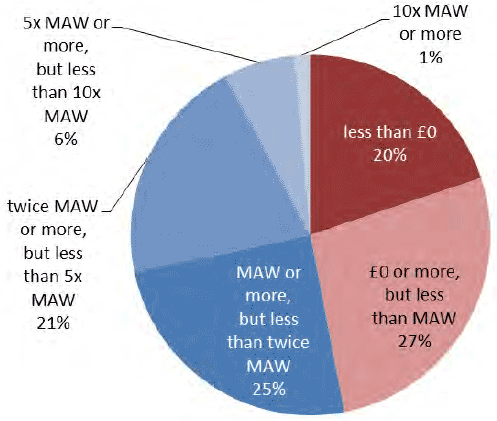Economic Report on Scottish Agriculture, 2016
Presents an overall picture of Scottish agriculture using data from the various agricultural surveys that RESAS manage.
This document is part of a collection
3.6 FBI per unpaid labour (Tables B1, B9)
FBI does not include imputed costs for the value of unpaid labour (farmer, spouse, other partners, directors and managers) who are, to some extent, dependent on the income of the farm business. The unpaid FTE (full-time equivalent) of a farm relates to the total number of hours worked by regular unpaid labour. One FTE is equivalent to 1,900 worked hours in a year. Chart 3.3, earlier in this publication, also shows the average FBI of Scottish farms per unit of unpaid labour.
Trends in FBI/ FTE roughly mirror overall FBI at a reduced level; typically around a third lower. In 2014-15 the overall average FBI/ FTE was £16,000 and it can be seen, in Figure 1, that the difference between FBI and FBI/ FTE was largest in 2010-11; reducing the value of FBI/ FTE in that year. Over the last year, the average FTE has remained relatively unchanged.
FBI/ FTE reveals more than FBI alone. When looking in more detail, for example by farm type (covered in later sections of this report), it can be seen that the average FTE varies. Therefore the finance available to remunerate unpaid labour, those with an entrepreneurial interest in the farm business, will also vary.
We can put the FBI/ FTE into context by comparing it to the minimum agricultural wage ( MAW) which farm owners are required to pay farm workers. Although the MAW may be less than what the person involved in this unpaid labour would expect to be paid, due to level of experience or qualifications, it is the legal minimum. It should also be noted that the income described by FBI should cover more than just the labour provided by the farm owner: there is also the unpaid management, provision for return on capital and provision of funds for further investment (beyond the depreciation charges included in costs). Comparison against the MAW is nonetheless a helpful indicator of the performance of farm businesses.
Chart 3.9 shows the distribution of FBI/ FTE relative to the MAW. The MAW is updated every year and takes effect from the start of October each year. Data collected through the FAS span calendar years, with 2014-15 data centred on 2014. For the purpose of this comparison a weighted MAW for the 2014 calendar year of £7.03 per hour has been used. The average FBI/ FTE of £16,000 is equivalent to an hourly wage for unpaid labour of £8.42, around 20 per cent more than the minimum agricultural wage in Scotland. It should be noted that other costs may need to be covered from the FBI and not all unpaid labour will be remunerated equally. There will also be differences in systems of farming and overheads between farms.
Chart 3.9: Average FBI/ FTE, relative to minimum agricultural wage ( MAW), 2014-15

From chart 3.9 we see that 47 per cent of farms generated an FBI/ FTE equivalent to less than the minimum agricultural wage, per hour of unpaid labour. At the top end, seven per cent generated an FBI/ FTE of at least five times the minimum agricultural wage, that is, at least £35.15 and per hour of unpaid labour. The remaining 46 per cent of farms generate an FBI/ FTE between one and five times the minimum agricultural wage.
Contact
There is a problem
Thanks for your feedback